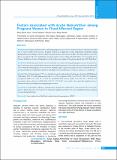Please use this identifier to cite or link to this item:
https://hdl.handle.net/20.500.14356/919| Title: | Factors Associated with Acute Malnutrition among Pregnant Women in Flood Affected Region |
| Authors: | Aryal, Binod Kumar Sapkota, Suman Lama, Nishant Paudel, Rajan |
| Citation: | AryalB. K., SapkotaS., LamaN., & PaudelR. (2022). Factors Associated with Acute Malnutrition among Pregnant Women in Flood Affected Region. Journal of Nepal Health Research Council, 20(02), 539-545. https://doi.org/10.33314/jnhrc.v20i02.4076 |
| Issue Date: | 2022 |
| Publisher: | Nepal Health Research Council |
| Keywords: | Acute malnutrition Flash Flood Malnutrition during pregnancy MUAC |
| Series/Report no.: | April-June, 2022;4076 |
| Abstract: | Abstract Background: Adequate nutrition before and during pregnancy is necessary to maintain women’s reproductive health and to ensure healthy foetal outcome. Pregnant women are at high risk of acute malnutrition specifically during humanitarian crisis leading to adverse effects in foetal outcomes and women’s health. This study aimed to assess the factors associated with acute malnutrition among pregnant women visiting Antenatal Clinics in two hospitals and a Primary Health Care Centre of Siraha district in the south-eastern plains of Nepal immediately after 2017 flash flood. Methods: A health-institution based cross-sectional study was conducted among 444 pregnant women of reproductive age (15-49 years) in second and third trimester in three health institutions. Data collection was done in the aftermath of 2017 flash floods through face to face interview. Multiple logistic regression analysis was used to identify the factors associated with acute malnutrition defined as Mid Upper Arm Circumference less than or equals to 21 centimetres. Results: Out of 444 participants, 9.9% were found to be acutely malnourished. Participant’s education (AOR[Adjusted Odds Ratio]: 3.09, 95% CI[Confidence Interval]: 1.43-6.70), occupation (AOR: 3.16, 95% CI: 1.08-9.22), husband’s occupation (AOR: 6.61, 95% CI: 2.17-20.12), household food security (AOR: 3.39, 95% CI: 1.36-8.49) and participant’s dietary diversity (AOR:10.06, 95% CI: 3.35-30.27) were found to be statistically significant factors associated with acute malnutrition among pregnant women. Conclusions: Participants’ silliteracy, unemployment, husband not employed for cash, household food insecurity and low dietary diversity were found to be statistically significant predictors of acute malnutrition among pregnant women during flash floods. Keywords: Acute malnutrition; flash flood; malnutrition during pregnancy; MUAC |
| Description: | Original Article |
| URI: | http://103.69.126.140:8080/handle/20.500.14356/919 |
| ISSN: | Print ISSN: 1727-5482; Online ISSN: 1999-6217 |
| Appears in Collections: | Vol 20 No 02 Issue 55 April-June, 2022 |
Files in This Item:
| File | Description | Size | Format | |
|---|---|---|---|---|
| 4076-Manuscript-29713-1-10-20221103.pdf | Full Article. | 267.09 kB | Adobe PDF |  View/Open |
Items in DSpace are protected by copyright, with all rights reserved, unless otherwise indicated.
